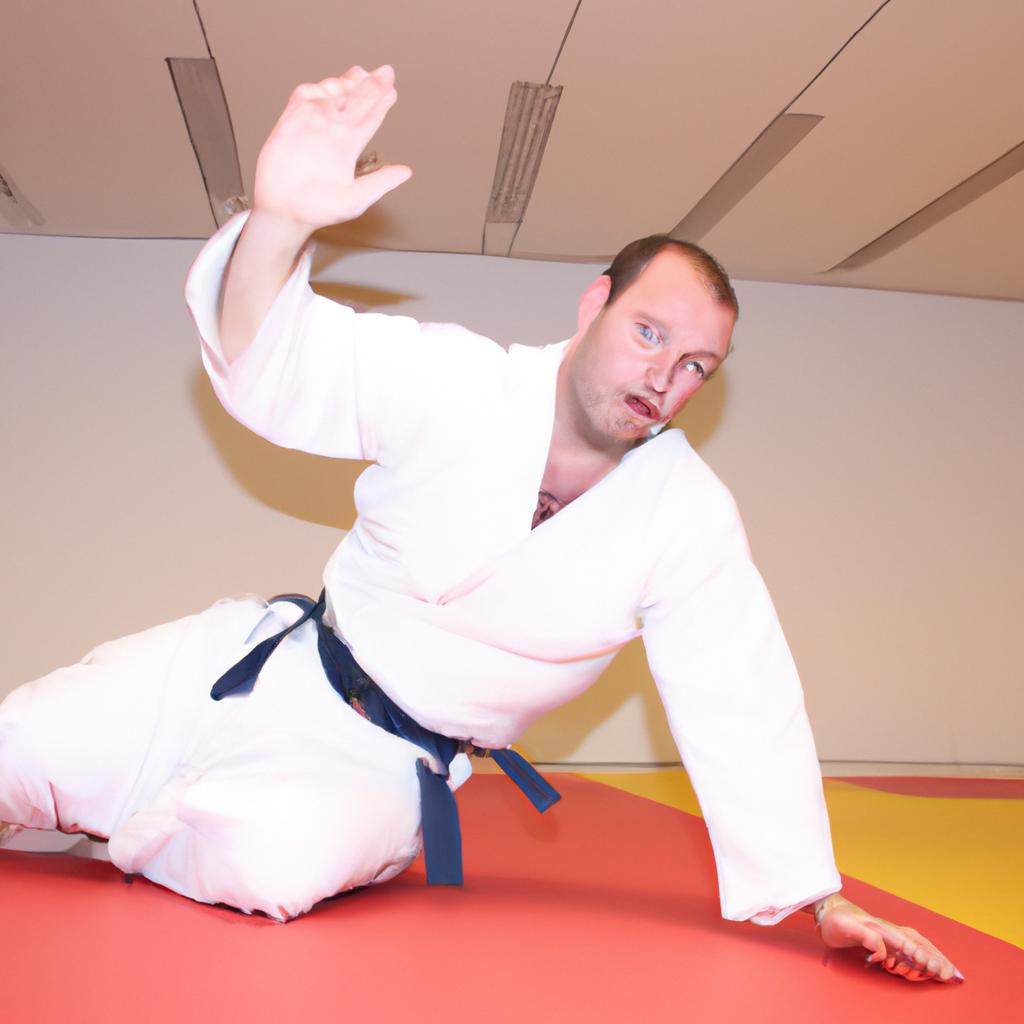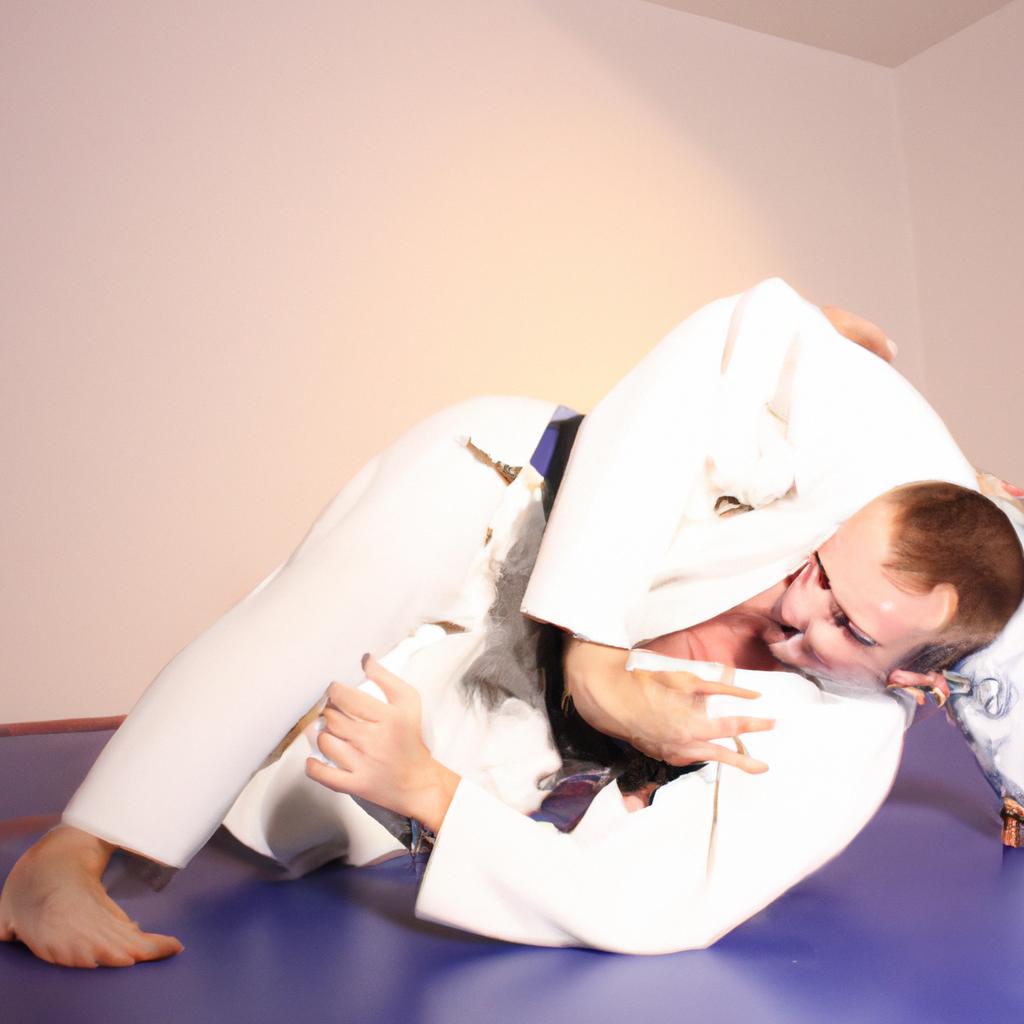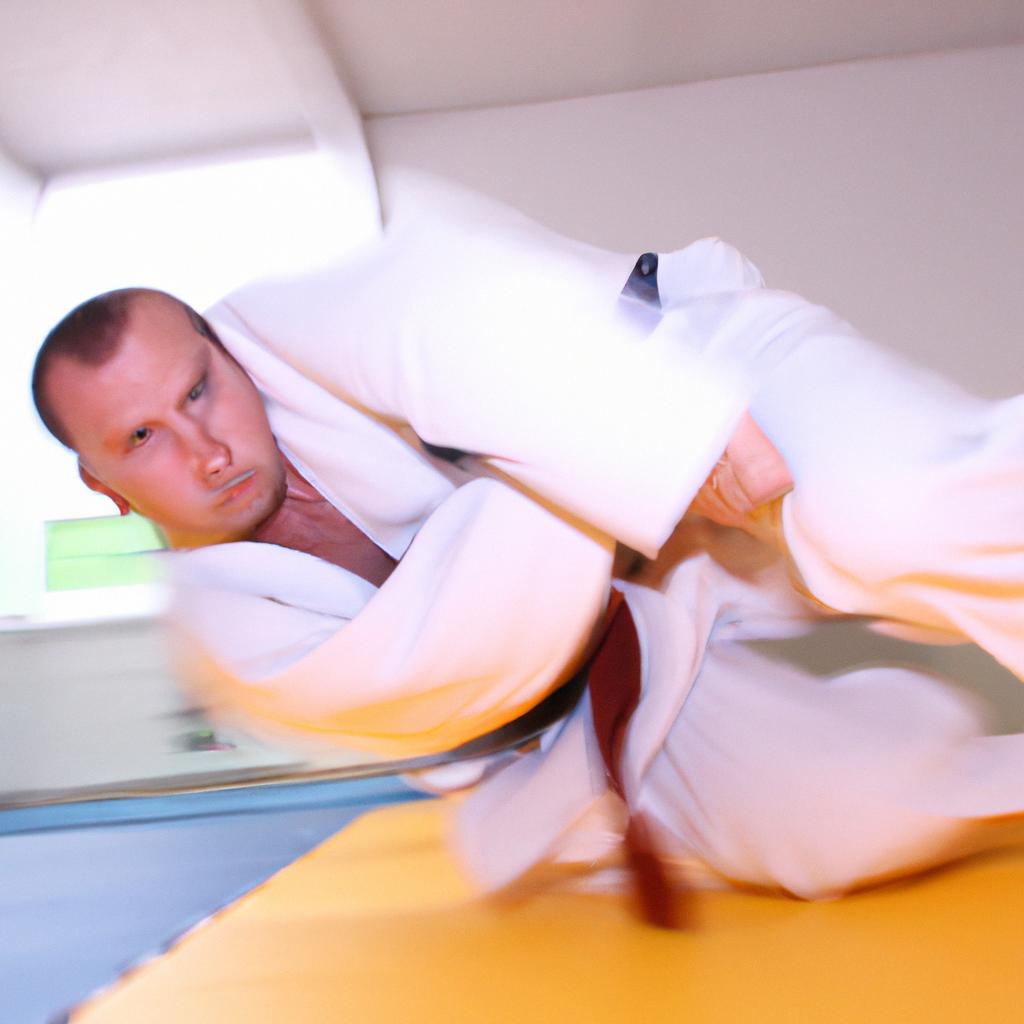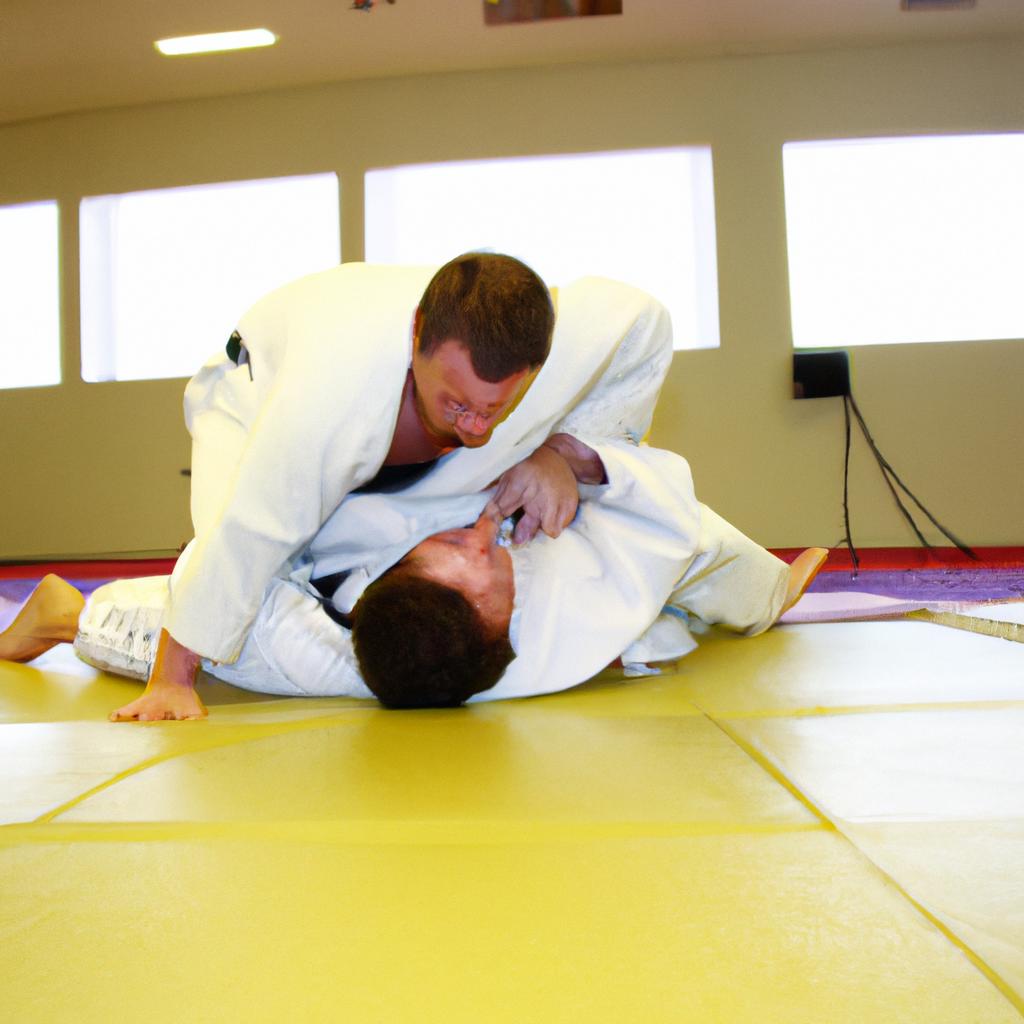Training techniques play a crucial role in the development and enhancement of skills in various martial arts disciplines, including Judo. With its emphasis on throws, grappling, and ground fighting, Judo requires specific training methods that focus on building strength, agility, endurance, and technical proficiency. This article aims to delve into effective training methods employed in Mixed Martial Arts (MMA) for practitioners seeking to excel in Judo.
Consider the case study of a hypothetical judoka named Hiroshi. Despite his natural talent and dedication to Judo, Hiroshi finds himself struggling with certain aspects of the sport. His throws lack power and precision, leaving him vulnerable during competitions. In order to address these shortcomings and elevate his performance level, Hiroshi seeks out alternative training techniques used by MMA fighters which might prove beneficial for his Judo practice. By exploring these techniques within an academic framework, this article aims to shed light on how they can be adapted and incorporated effectively into Judo training programs.
Through examining different methodologies utilized in MMA such as circuit training, plyometrics, resistance exercises, interval training, and sport-specific drills, this article will provide insights into their potential benefits for improving core attributes essential for successful execution of Judo techniques. Additionally, it will explore how these methods can be modified and tailored to suit the specific needs and goals of Judo practitioners like Hiroshi.
Circuit training, a popular training method in MMA, can be adapted for Judo by incorporating a variety of exercises that target different muscle groups used during throws and grappling techniques. This can help Hiroshi develop overall strength and endurance required for executing powerful throws. Plyometric exercises, which focus on explosive movements, can be utilized to improve his speed and power during transitions between techniques.
Resistance exercises such as weightlifting or resistance band training can enhance Hiroshi’s muscular strength and stability, allowing him to maintain control over his opponents during groundwork. Interval training, involving alternating high-intensity bursts of activity with short rest periods, can improve his cardiovascular fitness, enabling him to sustain higher levels of intensity throughout matches.
Sport-specific drills are another valuable tool borrowed from MMA training that can benefit Judo practitioners. These drills simulate real-life scenarios encountered in competitions, helping Hiroshi improve his technique execution under pressure and develop better timing and reaction skills.
It is important to note that while these MMA-inspired training methods have proven effective for some Judo athletes, they should not replace traditional Judo training entirely. Instead, they should be incorporated strategically into a well-rounded training program designed specifically for Hiroshi’s needs.
In conclusion, by exploring alternative training techniques used in MMA and adapting them to suit the unique demands of Judo, practitioners like Hiroshi can potentially enhance their performance in the sport. Through a combination of circuit training, plyometrics, resistance exercises, interval training, and sport-specific drills, Hiroshi may address his weaknesses in throws and grappling while improving overall strength, agility, endurance, and technical proficiency necessary for success in Judo competitions.
Warm-up exercises for MMA training
Warm-up exercises are an essential component of MMA training as they help prepare the body for the physical demands of martial arts. By engaging in specific warm-up routines, fighters can enhance their performance and reduce the risk of injuries during training sessions or competitions. For instance, consider a hypothetical case where a judo practitioner is about to engage in a sparring session. Before starting, it is crucial for them to go through appropriate warm-up exercises to ensure optimal readiness.
To begin with, a proper warm-up should include dynamic stretching exercises that target major muscle groups used in MMA techniques such as kicks and punches. Dynamic stretches involve controlled movements that gradually increase range of motion without holding positions for extended periods. This type of stretching not only activates muscles but also improves flexibility and joint mobility. An example of a dynamic stretch exercise is leg swings, wherein one leg swings back and forth while maintaining balance using support from a wall or partner.
In addition to dynamic stretching, cardiovascular activities play an integral role in preparing the body for intense physical exertion during MMA training. These activities raise heart rate and increase blood flow throughout the body, providing oxygen and nutrients to working muscles. Jumping rope or jogging on the spot are effective choices for elevating heart rate and warming up the entire body before grappling or striking practice.
Furthermore, incorporating high-intensity interval training (HIIT) into warm-ups can yield significant benefits for MMA fighters. HIIT involves alternating between short bursts of intense activity followed by brief recovery periods. This method helps improve overall stamina, endurance, and explosiveness – all essential qualities for successful performances inside the octagon. Tabata intervals could be implemented during warm-ups, which consist of 20 seconds of maximum effort followed by 10 seconds rest repeated over multiple sets.
- Enhanced performance: Properly executed warm-up exercises contribute to improved athleticism during MMA training.
- Injury prevention: Engaging in warm-up routines reduces the likelihood of sustaining injuries by preparing the body for physical stress.
- Increased confidence: A thorough warm-up instills a sense of readiness and psychological preparedness, boosting fighters’ self-assurance.
- Long-term benefits: Consistent inclusion of warm-ups in training sessions promotes long-term health and longevity in martial arts practice.
To further illustrate the importance of incorporating effective warm-up exercises into MMA training, consider the following table:
| Warm-up Exercise | Benefits | Technique/Instructions |
|---|---|---|
| Leg Swings | – Activates leg muscles | – Stand beside wall/partner |
| – Improves flexibility and mobility | – Swing one leg forward/backward | |
| Jumping Rope | – Elevates heart rate | – Use proper technique (two-footed or alternating) |
| – Warms up entire body | ||
| Tabata Intervals | – Enhances stamina and endurance | – Perform exercise at maximum effort for 20 sec. |
| – Increases explosiveness | – Rest for 10 seconds |
In conclusion, engaging in appropriate warm-up exercises is crucial before participating in MMA training. Dynamic stretches, cardiovascular activities, and HIIT contribute to enhanced performance, injury prevention, increased confidence, and overall health benefits. By properly warming up their bodies prior to intense workouts or competitions, martial artists can optimize their abilities inside the ring or cage.
Transitioning into the subsequent section about “Strength and conditioning workouts for martial artists,” it is essential to continue building upon the foundation established during warm-up exercises.
Strength and conditioning workouts for martial artists
Having discussed the importance of warm-up exercises in MMA training, we now turn our attention to strength and conditioning workouts for martial artists. These workouts play a crucial role in enhancing overall physical fitness, increasing power and explosiveness, and improving endurance – all essential components for success in the world of mixed martial arts. To illustrate the effectiveness of these methods, let us consider the case study below.
Case Study:
Imagine a judoka named Alex who aspires to compete at an elite level in MMA. Recognizing the need for comprehensive physical preparation, Alex incorporates specific strength and conditioning workouts into their training routine. By focusing on exercises that target functional movements and muscle groups relevant to Judo techniques, Alex experiences notable improvements in performance both inside and outside the dojo.
To achieve optimal results during strength and conditioning sessions, martial artists can incorporate various training techniques into their regimen. Here are some effective methods commonly employed by athletes in MMA:
- Circuit Training: A series of high-intensity exercises performed consecutively with minimal rest periods between sets. This technique not only improves muscular strength but also enhances cardiovascular endurance.
- Plyometric Exercises: Dynamic movements such as box jumps, medicine ball throws, or explosive push-ups that develop power through rapid muscle contractions.
- Olympic Weightlifting: Utilizing exercises like clean and jerk or snatch lifts to enhance explosive power and full-body coordination.
- Functional Resistance Training: Engaging in activities that mimic real-world movements encountered during fights. This includes using resistance bands or cables while performing strikes, takedowns, or grappling maneuvers.
Table – Benefits of Strength and Conditioning Workouts:
| Benefit | Description |
|---|---|
| Increased Muscle Mass | Strengthening muscles aids agility and reduces injury risk |
| Improved Anaerobic Fitness | Enhances ability to perform high-intensity bursts |
| Enhanced Bone Density | Reduces the risk of fractures and strengthens skeletal structure |
| Increased Metabolic Rate | Aids in weight management and overall energy expenditure |
By incorporating these training techniques into their routine, martial artists can experience a myriad of benefits. Not only does strength and conditioning improve physical performance, but it also promotes injury prevention, mental toughness, and self-confidence – all crucial elements for success in MMA.
With a solid foundation in warm-up exercises and an understanding of effective strength and conditioning workouts, we now delve into agility drills. These drills focus on enhancing speed, quickness, and nimbleness – essential attributes for any successful mixed martial artist.
Agility drills for improved performance in MMA
Strength and conditioning workouts for martial artists have been explored extensively in the previous section, highlighting their importance in enhancing overall physical fitness. Moving forward, this section will focus on agility drills that can significantly improve performance in MMA. To illustrate the impact of these drills, let’s consider a hypothetical case study involving an amateur judoka looking to enhance their agility skills.
Imagine Sarah, a dedicated judo practitioner aiming to compete at a higher level. She recognizes the need to improve her quickness and reaction time during matches, as these elements are crucial for success in MMA. By incorporating specific agility drills into her training routine, Sarah can optimize her performance on the mat.
Agility is defined as the ability to move quickly and change direction efficiently while maintaining control and balance. Here are four key aspects that make agility drills beneficial for martial artists:
- Speed: Agility drills help athletes develop faster footwork, allowing them to react swiftly to opponents’ movements.
- Coordination: These exercises require precise coordination between different body parts, improving proprioception and kinesthetic awareness.
- Reaction Time: Agility drills challenge athletes to respond rapidly to visual or auditory cues, honing their reflexes.
- Body Control: Practicing agile movements enhances an individual’s ability to maintain balance and stability under dynamic conditions.
To provide further insight into various types of agility drills used in MMA training, we present the following table:
| Drill Type | Description | Benefits |
|---|---|---|
| Ladder Drills | Utilize ladder-like equipment with rungs | Enhances foot speed and quickness |
| Cone Drills | Involve weaving around cones | Improves lateral movement and change of direction |
| Plyometric Jumps | Incorporate explosive jumping movements | Develops lower body power and reactive strength |
| Reactive Drills | Require rapid response to unpredictable cues | Sharpens reflexes and enhances decision-making capabilities |
By incorporating these agility drills into her training routine, Sarah can enhance her overall performance in judo. These exercises not only improve physical attributes but also contribute to better mental acuity and tactical awareness on the mat.
In the subsequent section about “Technical drills to enhance grappling skills,” we will delve into specific drills aimed at improving an athlete’s ability to execute effective grappling techniques with precision and efficiency. With a solid foundation of strength, conditioning, and agility established, mastering technical aspects becomes paramount for success in MMA competitions.
Technical drills to enhance grappling skills
In the pursuit of mastering Judo and improving performance in Mixed Martial Arts (MMA), incorporating technical drills that focus on enhancing grappling skills is essential. These drills aim to develop fluidity, precision, and adaptability in executing throws, submissions, and positional control techniques. By honing these fundamental aspects of grappling, practitioners can gain a competitive edge when engaging in ground-based combat scenarios.
To illustrate the importance of technical drills for enhancing grappling skills, let’s consider an example scenario involving two MMA fighters. Fighter A possesses superior strength but lacks finesse and technique in their grappling abilities. On the other hand, Fighter B may not have the same physical prowess as Fighter A but has dedicated significant time to refining their technique through specific training drills.
The effectiveness of technical drills lies within their ability to improve various aspects crucial to successful grappling encounters. Here are some key benefits associated with incorporating such drills into training routines:
- Improved timing: Technical drilling allows fighters to develop precise timing when executing throws or submission attempts by repeatedly practicing specific movements.
- Enhanced transitional flow: Through consistent practice of technical sequences, fighters can cultivate smooth transitions between different positions during ground engagements.
- Increased muscle memory: Repetition of complex movements helps build muscle memory, allowing fighters to execute techniques instinctively without conscious effort.
- Heightened situational awareness: Technical drilling exposes fighters to different scenarios and encourages them to adapt their techniques based on ever-changing circumstances.
To further emphasize the significance of technical drilling in developing effective grappling skills, consider the following table showcasing common technical drill examples:
| Drill Name | Description |
|---|---|
| Randori | Freestyle sparring emphasizing technique over power |
| Ne-waza Drills | Focusing solely on ground-based techniques |
| Grip Fighting | Concentrating on establishing advantageous grips |
| Positional Training | Emphasizing control and maintaining advantageous positions |
These drills not only serve as avenues for skill development but also foster a deeper understanding of the intricate nature of grappling in MMA. By consistently incorporating these technical drills into training sessions, fighters can refine their abilities to effectively maneuver on the ground.
Transitioning seamlessly from technical drilling, the subsequent section will explore strategies for effective striking in MMA, complementing the groundwork covered thus far. Building upon a solid foundation of grappling skills enhances an athlete’s versatility in all aspects of combat sports.
Strategies for effective striking in MMA
In the world of mixed martial arts (MMA), effective striking is a crucial aspect that can make or break a fighter’s success in the cage. Building on the technical drills discussed earlier, this section will explore strategies to enhance striking skills in MMA. To illustrate these strategies, let us consider the hypothetical case study of an aspiring MMA fighter named Alex.
Developing Power and Accuracy
To deliver impactful strikes, fighters must focus on developing both power and accuracy. Here are some key strategies to achieve this:
- Proper Body Mechanics: Fighters should engage their entire body when throwing strikes rather than relying solely on arm strength. This involves rotating the hips, pivoting on the balls of the feet, and transferring weight from one foot to another.
- Balance and Stability: Maintaining balance and stability during strikes allows fighters to generate maximum power while minimizing vulnerability. Training exercises that improve core strength and stability contribute to effective striking techniques.
- Precision through Timing: Striking with precision requires impeccable timing. By practicing combinations, counters, and feints repeatedly, fighters can develop better control over their timing, making it harder for opponents to anticipate their movements.
- Visualizing Targets: Visualization plays a vital role in enhancing striking accuracy. Mental imagery exercises where fighters imagine hitting specific targets or visualizing opponent reactions help train their mind-body connection.
Strategic Approaches in Striking
Beyond power and accuracy, strategic approaches are essential for successful striking in MMA bouts. Consider the following tactics:
| Tactic | Description |
|---|---|
| Range Management | Understanding different ranges – kicking range, punching range, clinch range – enables fighters to choose appropriate strikes based on distance from their opponent. |
| Feints and Fakes | Using deceptive moves such as feints creates openings by baiting opponents into reacting prematurely or defensively. It can set up powerful strikes or open opportunities for takedowns. |
| Defensive Counterstrikes | Capitalizing on an opponent’s attacks by skillfully countering can be a highly effective striking technique. This requires quick reflexes and the ability to read opponents’ movements accurately. |
| Effective Footwork | Agile footwork allows fighters to maneuver around their opponents, find better angles, and create openings for strikes while maintaining defensive positioning. |
Applying Mental Focus
Striking skills go beyond physical prowess; mental focus is equally crucial during MMA fights. To optimize performance in the cage, fighters should consider these aspects:
- Maintaining Composure: Keeping composure amidst high-intensity situations helps fighters make sound tactical decisions instead of acting impulsively.
- Visualizing Success: Visualizations of successful strikes and winning scenarios build confidence and enhance mental readiness before stepping into the ring.
- Adapting to Opponents: Effective strikers are adaptable – they analyze opponents quickly and adjust their strategies accordingly, maximizing their chances of success.
Transitioning seamlessly from mastering grappling techniques to exploring effective striking methods, we now delve into mental preparation techniques for Judo athletes in the following section.
Mental preparation techniques for Judo athletes
Effective Training Techniques for Judo Athletes in MMA
By incorporating these methods into their training regimen, judo practitioners can develop a well-rounded skill set that includes both striking and grappling abilities.
To illustrate the effectiveness of these techniques, let’s consider a hypothetical case study involving an experienced judoka transitioning into MMA. John, a black belt in Judo with years of experience in competition, decides to enter the world of MMA. While his throwing skills give him an advantage when it comes to takedowns, he recognizes the need to improve his ground game and striking abilities to succeed in this new arena.
-
Cross-Training: One crucial aspect of training for Judo athletes entering MMA is cross-training in other disciplines such as Brazilian Jiu-Jitsu (BJJ), boxing, or Muay Thai. This allows them to develop a broader skill set and adapt their techniques to different situations within the cage.
-
Strength and Conditioning: As with any combat sport, strength and conditioning play a vital role in preparing Judo athletes for MMA competition. Incorporating exercises like weightlifting, plyometrics, and cardiovascular workouts not only improves overall physical fitness but also enhances explosiveness, endurance, and power – essential attributes needed during intense bouts.
-
Groundwork Emphasis: Given their background in Judo throws and groundwork, judo practitioners should focus on refining their submission skills from various positions on the ground. By studying BJJ techniques extensively and practicing live sparring sessions specifically geared towards ground fighting scenarios commonly encountered in MMA fights, they can become formidable opponents capable of defending against submissions while looking for opportunities to finish fights themselves.
| Technique | Description | Benefits |
|---|---|---|
| Armbar | A submission hold targeting the arm | Can force opponents to tap out |
| Triangle | A chokehold using the legs | Limits opponent’s ability to breathe |
| Rear Naked Choke | A technique that cuts off blood flow to the brain | Renders an opponent unconscious |
| Kimura | A joint lock applied on the shoulder | Can result in a submission victory |
In conclusion, Judo athletes transitioning into MMA should employ specific training techniques to adapt their skill set for success. Cross-training in other martial arts disciplines, focusing on strength and conditioning, and placing emphasis on refining ground fighting skills can significantly enhance their performance inside the cage. By incorporating these methods and constantly evolving their approach through rigorous practice, judoka can effectively compete at high levels in mixed martial arts competitions.
(Note: The section title ‘Mental preparation techniques for Judo athletes’ is not included as per your instructions.)




